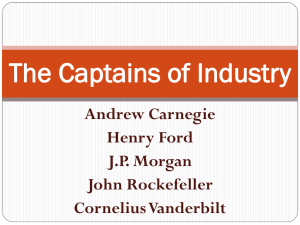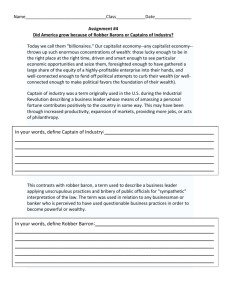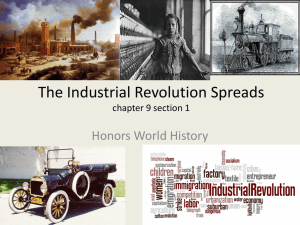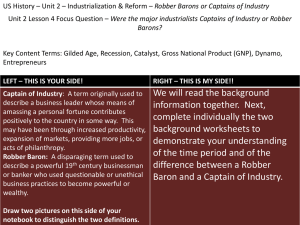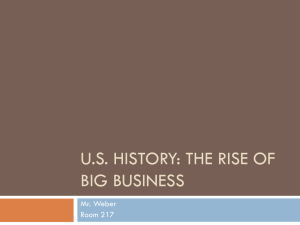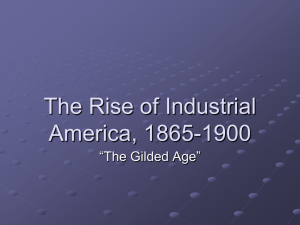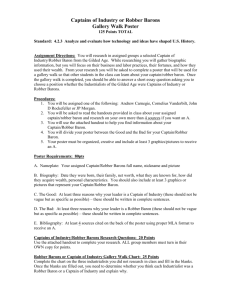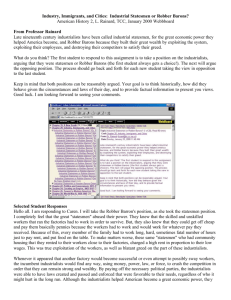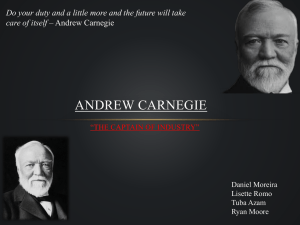Captains of Industry - pams-byrd
advertisement
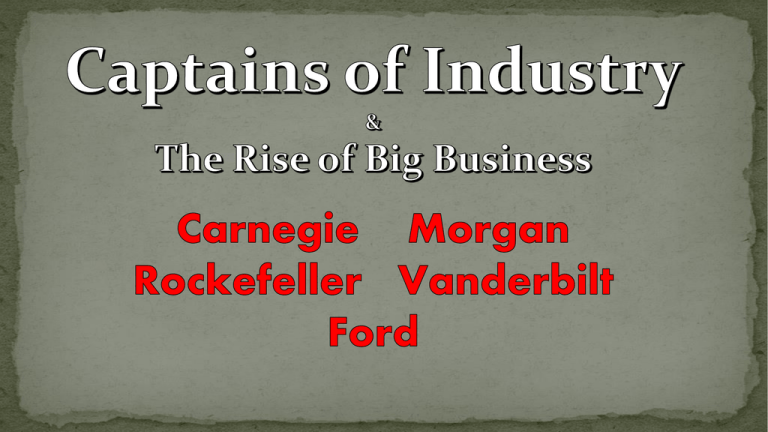
National markets created by transportation advances Advertising Lower-cost production Lighting and mechanical uses of electricity (Thomas Edison). Telephone service (Alexander Graham Bell) Child labor Low wages, long hours Unsafe working conditions (Sweat shops) Formation of unions American Federation of Labor: focused on higher wages, better working conditions, and a shorter work week for its members. Knights of Labor: focused on an eight-hour work day, termination of child labor Andrew Carnegie’s Steel Company Carnegie Steel helped to build America – from the railroads spanning the country to the skyscrapers touching the sky to the Brooklyn Bridge, connecting the major population centers of New York. How he acquired his wealth: Gained control of every step of the steel making process Carnegie Steel Company How he (or his related industries) treated workers: Homestead strike: cut wages then locked out workers who demanded more money. Hired a private army to take control. Nine workers were killed. How he spent his money: books, music, and the fine arts How he donated his money: “Gospel of Wealth” (rich had a duty to improve society); Libraries Robber Baron or Captain of Industry? James Pierpont Morgan By using his banks to invest in troubled railroads – then merging the railroads with rival companies to decrease competition and increase prices – J.P. Morgan was able to make an enormous fortune. His companies were known for unfair business practices. How he acquired his wealth: Accounting and banking; used trusts to control American industry How he (or his related industries) treated workers: Coldly rational; used aggressive tactics to root out troublemakers How he spent his money: Art; cigars; gems; yachts first house in NY to have electricity How he donated his money: Libraries; Art museums Robber Baron or Captain of Industry? John D. Rockefeller The Standard Oil Trust How he acquired his wealth: bought out oil companies controlled most of the refining and shipping process How he (or his related industries) treated workers: Bought out competition price slashing How he spent his money: Simple and frugal personal life How he donated his money: Universities organization to set up free high schools Robber Baron or Captain of Industry? Cornelius Vanderbilt, Railroad Baron Cornelius Vanderbilt consolidated most of the Railroads in the state of New York and created a vast fortune for himself and his family. Like many other aristocrats of the Gilded Age, he became a great philanthropist after accumulating great wealth. How he acquired his wealth: railroads (The Central Railroad) & shipping How he (or his related industries) treated workers: Building the Grand Central Terminal helped employ thousands. Workers were paid very little and worked long hours. How he spent his money: Built a yacht and toured Europe; Staten Island mansion; Biltmore Estate How he donated his money: Largest endowment to a University; wife’s church; left 95% of estate to eldest son Robber Baron or Captain of Industry? Henry Ford Ford’s development of the assembly line technique of mass production made enabled him to produce an automobile the middle class could afford. He was known for high wages, hiring all races, and even recruiting outside the country. His hiring practices made Detroit one of the most racially diverse cities in America. How he acquired his wealth: Automobile assembly line Ford Motor Company How he (or his related industries) treated workers: High wages for workers; 40-hour work week Demanded “Socially Moral” employees How he spent his money: Racecars How he donated his money: Created a museum Paid children’s hospital bills Robber Baron or Captain of Industry?
